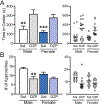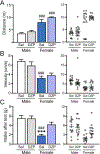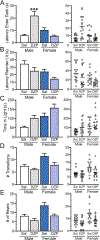Sex differences in specific aspects of two animal tests of anxiety-like behavior
- PMID: 34120205
- PMCID: PMC11071636
- DOI: 10.1007/s00213-021-05893-w
Sex differences in specific aspects of two animal tests of anxiety-like behavior
Abstract
Rationale: Anxiety, a negative state of high arousal and vigilance, is especially prevalent in women, making identification of underlying mechanisms critical for developing effective therapies. With the challenge of disentangling biological and social factors in humans, animal tests can provide valuable insights, although such tests, developed in males, have unclear validity for females.
Objective: To better understand patterns of sex differences across multiple measures within two classical rodent anxiety tests.
Methods: We examined female and male adult Wistar rats (n = 15-18/group) that were single-housed in the novelty suppression of feeding test (NSFT) that involves food under a bright light in food-restricted animals, and light-dark test (LDT), which reflects innate aversion to bright light. To further validate these tests in females, we also examined the impact of 1 mg/kg diazepam.
Results: NSFT measures of the most direct interaction with food, latency to grab food and food consumed, indicated increased anxiety-like behavior in females versus males, with diazepam altering these behaviors in females but not males. Most other measures showed more similar effects of diazepam across the sexes, with some evidence of reduced anxiety-like behavior in LDT for females. Principal component analyses indicated limited relationships across behavioral factors, underscoring previous suggestions of the importance of assessing multiple measures to maximize information and ethological relevance.
Conclusions: Combining our findings and previous studies, we speculate that increased anxiety-like behavior in females manifests especially when there is a specific, life-relevant condition (e.g., food in the NSFT). Our findings also validate NSFT and LDT use in females.
Keywords: Anxiety; Diazepam; Females; Light–dark box; Novelty-suppressed feeding; Sex difference.
© 2021. The Author(s), under exclusive licence to Springer-Verlag GmbH Germany, part of Springer Nature.
Figures





References
-
- Abramov U, Raud S, Koks S, Innos J, Kurrikoff K, Matsui T, Vasar E. (2004) Targeted mutation of CCK(2) receptor gene antagonises behavioural changes induced by social isolation in female, but not in male mice. Behav Brain Res 155:1–11. - PubMed
-
- Albonetti ME, Farabollini F. (1995) Effects of single restraint on the defensive behavior of male and female rats. Physiol Behav 57:431–437. - PubMed
MeSH terms
Substances
Grants and funding
LinkOut - more resources
Full Text Sources

